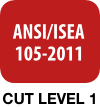The Portwest A140 Thermal Grip Glove is perfect for construction, transportation, refuse collection, maintenance and local authority work.
The A140 glove has a warm acrylic 10 gauge liner and is ideal for more heavy duty, outdoor tasks or those people working in cold conditions.



EN 420, EN 388, EN511, ANSI/ISEA 105-2011
Carton quantity available 144 pairs.
More Portwest Gloves
Product Technical Information
Standards
- EN ISO 21420: 2020 Dexterity 4
- EN 388: 2016 + A1: 2018 - 1141X
- EN 511: 2006 X1X
- ANSI/ISEA 105: 2016 CUT Level A1
Documentation
Protective Gloves : General Requirements
EN420 : 2003 + A1 2009
This standard defines the general requirements for glove design and construction, innocuousness, cleaning instructions, electrostatic properties, sizing, dexterity, water vapour transmission and absorption along with marking and information
EN 388
Gloves giving protection from mechanical risks
Protection against mechanical hazards is expressed by a pictogram followed by four numbers (performance levels), each representing test performance against a specific hazard.
1 Resistance to abrasion
Based on the number of cycles required to abrade through the sample glove (abrasion by sandpaper under a stipulated pressure). The protection factor is then indicated on a scale from 1 to 4 depending on how many revolutions are required to make a hole in the material. The higher the number, the better the glove. See table below.
2 Blade cut resistance
Based on the number of cycles required to cut through the sample at a constant speed. The protection factor is then indicated on a scale from 1 to 4.
3 Tear resistance
Based on the amount of force required to tear the sample.
The protection factor is then indicated on a scale from 1 to 4.
4 Puncture resistance
Based on the amount of force required to pierce the sample with a standard sized point. The protection factor is then indicated on a scale from 1 to 4.

Protective Gloves Against Cold
EN 511:2006
The European standard specific the requirements the test methods for gloves which product against conductive cold down to -50degrees Celsius. This cold can be linked to the climate conditions or an industrial activity.
Requirements
Performance levels 0-1
c) water penetration
Performance levels 1-4
B) Resistance to contract cold
Performance levels 1-4
A) Resistance to convective cold
ANSI/ISEA 105-2011
American National a Standard for Hand Protection
This standard addresses the classification and testing of hand protection for specific performance properties related to chemical and industrials applications. Hand protection includes gloves, mittens, partial gloves, or other items covering the hand or a portion of the hand that are intended to provide protection against or resistance to a specific hazard.